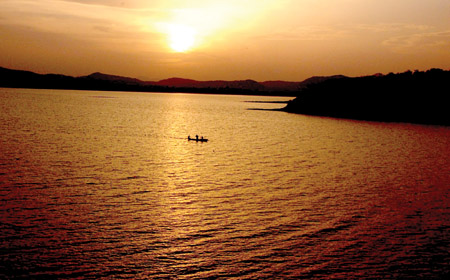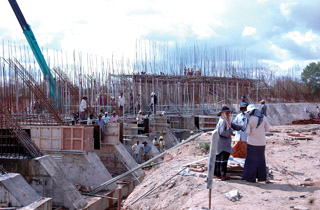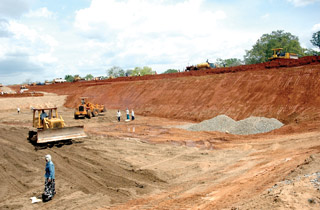Ancient irrigation system still 'holds water'
Uses maximum local human resources:
| Regulation of water flow,
in important rivers with dams at suitable locations, and
transbasin diversions according to regional water balance plan
is one important aspect in the multipurpose development
objectives.
|
| Major projects -
*Uma Oya Multi
purpose mega
project
*Yan oya reservoir
project
*Heda Oya reservoir
project
*Urawa diversion project from Nilwala river
*Gal Oya Navodaya |
By Dhaneshi YATAWARA
[email protected]
We are a nation inheriting a proud history filled with marvellous
creations by our ancestors. On top of all the achievements our ancestors
gifted us a magnificent hi-tech irrigation system unique in the world.
Even today the engineering capabilities of our forefathers have
astonished the foreigners.
Water is one of the most valuable resources a country is gifted with.
We Sri Lankans are blessed to have ample fresh water resources and
continuous precipitation cycles throughout the year. We have never had
prolonged droughts, desert or such extreme dry conditions. Hence, we are
gifted with an ever green nature.
We belong to a highly sophisticated hydraulic civilization which
continued for thousands of years. This ancient civilization was the main
reason for the successful agricultural economy we were once noted for.
The ancient settlers, believed to have migrated from the Indian
subcontinent, choose the North Central (Rajarata) and the South Eastern
(Ruhunu) plains along the river as their niche. Though the land was
excellent for agriculture, the difficulty in diverting enough water to
their cultivations was the main problem. Hence the magnificent
irrigation schemes were born. We were depending on an agriculture-based
economy which prospered in our glorious past until the advent of the
european colonizers. Our forefathers knew perfectly well as to how to
divert a mass flow of water to their cultivated lands through narrow
irrigation canals; they knew the most advanced and environment-friendly
method of building huge reservoirs even as early as the 6th century B.C.
As a result we owned three main complex irrigation systems, i.e.
Malwathu Oya-Kala Oya, Mahaweli-Amban Ganga and Walawe-Kirindi Oya
irrigation systems. According to our written history as depicted in the
'Mahawansa,' the oldest is the 'Basawakkulama' (Abhaya Wewa or the
tank), built by King Pandukabhaya in 4th century B.C. and in the 3rd
century B.C. 'Thisa wewa' in Anuradhapura was built by King
Devanampiyathissa and in the same era 'Yodha Kandiya Wewa' near
Thissamaharama was believed to be built by King Mahanaga. These are a
few of the living monuments of the earliest stages of this technology.
According to historical descriptions building giant-sized reservoirs
had been started in the 1st century B.C. during the reign of King
Wasabha (67 - 111 B.C.). According to the historical records the king
built 11 large reservoirs and two irrigation canals.The magnificent 'Parakrama
Samudra' built by the great King Parakramabahu in the twelfth century is
astounding.
|

Sunset at Parakrama Samudraya. |
We are still deeply rooted in our agriculture based economy. The
irrigation systems make a substantive contribution to the development of
an efficient agriculture sector. Hence the need for mega projects such
as the Galoya and Mahaweli irrigation systems is on the increase.
Approximately 80% of our population is still concentrated on rural areas
where farmers in large numbers engage in agriculture. We are blessed
with a very fertile soil and an excellent climate. Undoubtedly, we can
become a self sufficient nation if every inch of the land is brought
under cultivation.
Realizing the importance of irrigation and water management the
present Government, established the Ministry of Irrigation and Water
Management in the year 2007 under Minister Chamal Rajapaksa. Its main
objective is to improve the efficiency of irrigation and drainage and
ensure the optimum utilization of water resources for enhancing
agricultural production and the living standards of the farming
community of the country.
The Ministry and the implementing agencies have taken up on priority
basis the following multi purpose irrigation projects according to a
National Irrigation Plan.
Menik Ganga diversion project (Weheragala reservoir)
Deduru Oya reservoir project
Kekiri Obada reservoir project (Kirama Oya)
Rambukkan Oya reservoir project
Heda Oya Reservoir project
Yan Oya reservoir project
Uma Oya reservoir project
Urawa Diversion and Gin-Nilwala diversion project
Veheragala reservoir under Menik Ganga development is almost nearing
completion. Kekiroboda in Kirama Oya basin, Deduru oya reservoir and
Rambukkan Oya reservoir are in progress.
These large scale projects will have a lasting impact on the
development of the regions and the river basins. Their contribution to
overall economy is significant.
|

Rambukkan Oya project. |
|

Uma Oya multi purpose project in progress. |
 |
The Weheragala project aims at benefiting a part of the Hambanthota
district specially by providing an additional water supply to the
Lunugamwehera reservoir built by obstructing the nearby Kirindi Oya. The
project will ensure a continuous water supply to the Manik Ganga.
Relocating illegal settlers in the Lunugamwehera national park, creating
grasslands as fodder for the cattle and reconstructing the roads inside
the park as well as protecting the natural reserve will be additional
responsibilities coming under the project. The total project costs
around 1722 million rupees. The Deduru Oya protect in the Northwestern
Province, is expected to cultivate 27,000 acres of paddy. In addition a
power plant generating 1.5 mega watts is included under the project. The
project is expected to be finalized by 2010.
The Kekiriobada project is implemented in the Walasmulla pradeshiya
sabha area in the Hambanthota district crossing the Kekiri Oya - a
branch of the Kirama Oya.
The Rambukkan oya reservoir project focuses on benefiting the farmers
of the Maha Oya area in the Ampara district. This reservoir is believed
to be built by King Sadhdhathissa. The reconstruction started in the
year 2007 with a total provision of 2500 million rupees. It is expected
to finish by 2010.
The Yan Oya reservoir project benefits the Anuradhapura and
Trincomalee districts while the Heda Oya reservoir project caters to the
Ampara district.
The Urawa diversion from Nilwala river is to stabilize Nilwala,
Kirama Oya, Muruthawela and Chandrika Wewa systems and the Gal Oya
Navodaya (revival) is to support the projects under the Eastern revival.
The Gal Oya Navodaya proposal in the Ampara district is aimed at opening
a new chapter in the Gal Oya valley. The proposed package of projects
will address the sector goals, regional and national objectives.
On top of all, is the Uma Oya project, initiated with the assistance
of the Iranian Government. It will benefit mainly the Moneragala and
Hambanthota districts.
These projects, which benefit large extents of existing lands will
also embrace a substantial extent of new lands to be developed.
Unregulated flows in these rivers will be stored or diverted to provide
the facilities downstream; with other infrastructure in place and
assured water supplies.
Projects are identified or conceptualized for irrigation and
multipurpose development including hydro power, flood protection and
salt water exclusion. Under this, Kelani Ganga basin development
including flood mitigation and urban water supply, Ratnapura in Kalu
ganga and Kalu-Gin-Nilwala complex with options to divert water to the
southestern dry zone is a modified proposal. Preliminaries and
feasibility studies are to be completed.
The ministry has launched a comprehensive development program in
keeping with 'Mahinda Chinthanaya' in the irrigation and water resource
sectors.
Uplift of the rural economy and installation of a firm water-related
infrastructure for the growth and expansion of the agricultural sector
are the main objectives. It will be according to a national irrigation
plan incorporated in the 10 year development frame work. The National
Irrigation plan with river basins development strategies is to be
adopted according to a master plan and projects and programs are
formulated and implemented accordingly. In parallel with the other
development activities, an islandwide program for appreciation of the
irrigation civilization of Sri Lanka and conservation and protection of
the heritage by awareness and betterment of water management is
implemented, named 'Nil diyawara - Keth Yayata'. This will contribute to
the overall national effort in this sector.
The dry zone and water stressed parts of the island are to be
transformed in to fertile agricultural lands. These new projects are
implemented in order to harness unutilized water resources, including
more storage facilities and trans-basin diversions.
According to the statistics gathered by the Ministry 2005/06 maha
season average yield in irrigated areas was 4.66 metric tons per hectare
and in the maha season of 2006/07 it increased to 4.95 metric tons per
hectare. And during the yala cultivation period the results were the
same. Out of the country's total paddy production around 53% of yield
came from inter-provincial major irrigation systems. These projects are
implemented in such a manner that it uses maximum local human resources.
The funds for these projects will benefit the people living in those
areas, where the project will be implemented by generating employment
opportunities to the rural folk. Regulation of water flow, in important
rivers with dams at suitable locations, and transbasin diversions
according to regional water balance plan is one important aspect in the
multipurpose development objectives. |
